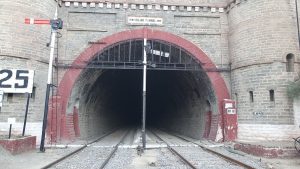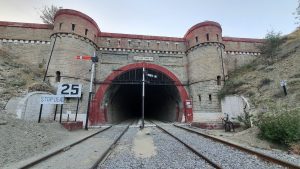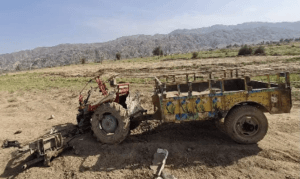Syed Ali Shah:
After driving for two hours from Quetta, we finally reached the Shela Bagh Khojak tunnel on an autumn evening. The weather was cold dry and calm prevailed in the valley located in the middle of rugged mountains.
I thought the security personnel would stop us from making a video report and making photos of the historic tunnel. Moreover, none stopped us from doing so. Two employees of Pakistan Railways were staring at us when we stepped down to portray a photograph outside the historic tunnel.
The railway employees preferred not to stop us. It was my quest to stand before the tunnel and educate the people about the history. In one attempt, I managed to complete the v log and report about the history of the tunnel, which snakes through the rugged mountains.

Britians constructed the tunnel from 1888 to 1891
The British rulers constructed the 4 kilometer long tunnel from 1888 to 1891 to counter the then powerful Russians from invading the sub-continent via Afghanistan. British engineers, technicians and local labourers made history by constructing the tunnel within three years. Although, there was no latest machinery at that time.
Historians said the Britians used mules, donkeys and horses to shift heavy stones from one place to another place to ensure timely completion of the project. 1891, the project is still intact as a passenger train passes through the tunnel on a daily basis from Quetta to Chaman.
Outside the historic #SheilaBagh tunnel constructed from 1888 to 1891…it is 4km long tunnel constructed within 3 years #Chaman Britians laid down Railway track from Delhi to Chaman to counter the Russians pic.twitter.com/JvqGv1Ueal
— Syed Ali Shah (@alishahjourno) October 5, 2022
British rulers were concerned about Russian attack
The great game was about to expand in the region and British rulers were concerned about the invasion of Russsians via Khyber Pass and Chaman through Afghanistan. They laid down railway track from Delhi to Chaman within a decade to make sure timely presence of military and weapons in the case of Russian attack.
On the front of the tunnel, on a small plate, its name and the period of its construction are inscribed. It lies at an altitude of 1,939.8 metres above sea level in the settlement of Shela Bagh. ‘Shala’ is a Pashto word which means a seasonal mountainous river, and ‘bagh’ of course means a garden.
The State Bank of Pakistan recognized this historic engineering and printed the tunnel’s photo of five rupees note from 1976 to 2005.






